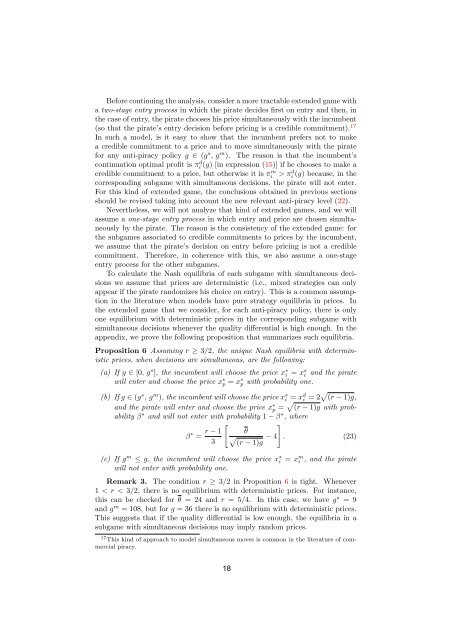Download PDF - Ivie
Create successful ePaper yourself
Turn your PDF publications into a flip-book with our unique Google optimized e-Paper software.
Before continuing the analysis, consider a more tractable extended game with<br />
a two-stage entry process in which the pirate decides first on entry and then, in<br />
the case of entry, the pirate chooses his price simultaneously with the incumbent<br />
(so that the pirate’s entry decision before pricing is a credible commitment). 17<br />
In such a model, is it easy to show that the incumbent prefers not to make<br />
a credible commitment to a price and to move simultaneously with the pirate<br />
for any anti-piracy policy g ∈ (g s , g m ). The reason is that the incumbent’s<br />
continuation optimal profit is πi d (g) [in expression (15)] if he chooses to make a<br />
credible commitment to a price, but otherwise it is πi<br />
m > πi d (g) because, in the<br />
corresponding subgame with simultaneous decisions, the pirate will not enter.<br />
For this kind of extended game, the conclusions obtained in previous sections<br />
should be revised taking into account the new relevant anti-piracy level (22).<br />
Nevertheless, we will not analyze that kind of extended games, and we will<br />
assume a one-stage entry process in which entry and price are chosen simultaneously<br />
by the pirate. The reason is the consistency of the extended game: for<br />
the subgames associated to credible commitments to prices by the incumbent,<br />
we assume that the pirate’s decision on entry before pricing is not a credible<br />
commitment. Therefore, in coherence with this, we also assume a one-stage<br />
entry process for the other subgames.<br />
To calculate the Nash equilibria of each subgame with simultaneous decisions<br />
we assume that prices are deterministic (i.e., mixed strategies can only<br />
appear if the pirate randomizes his choice on entry). This is a common assumption<br />
in the literature when models have pure strategy equilibria in prices. In<br />
the extended game that we consider, for each anti-piracy policy, there is only<br />
one equilibrium with deterministic prices in the corresponding subgame with<br />
simultaneous decisions whenever the quality differential is high enough. In the<br />
appendix, we prove the following proposition that summarizes such equilibria.<br />
Proposition 6 Assuming r ≥ 3/2, the unique Nash equilibria with deterministic<br />
prices, when decisions are simultaneous, are the following:<br />
(a) If g ∈ [0, g s ], the incumbent will choose the price x ∗ i = xs i and the pirate<br />
will enter and choose the price x ∗ p = x s p with probability one.<br />
(b) If g ∈ (g s , g m ), the incumbent will choose the price x ∗ i = xd i = 2√ (r − 1)g,<br />
and the pirate will enter and choose the price x ∗ p = √ (r − 1)g with probability<br />
β ∗ and will not enter with probability 1 − β ∗ , where<br />
β ∗ = r − 1<br />
3<br />
[<br />
θ<br />
√<br />
(r − 1)g<br />
− 4<br />
(c) If g m ≤ g, the incumbent will choose the price x ∗ i<br />
will not enter with probability one.<br />
]<br />
. (23)<br />
= xm i<br />
, and the pirate<br />
Remark 3. The condition r ≥ 3/2 in Proposition 6 is tight. Whenever<br />
1 < r < 3/2, there is no equilibrium with deterministic prices. For instance,<br />
this can be checked for θ = 24 and r = 5/4. In this case, we have g s = 9<br />
and g m = 108, but for g = 36 there is no equilibrium with deterministic prices.<br />
This suggests that if the quality differential is low enough, the equilibria in a<br />
subgame with simultaneous decisions may imply random prices.<br />
17 This kind of approach to model simultaneous moves is common in the literature of commercial<br />
piracy.<br />
16

















